
APRIL 1, 2013 VOLUME 6 ISSUE 1 (past issues)
3D Printer Models Released for Commercial Airplanes
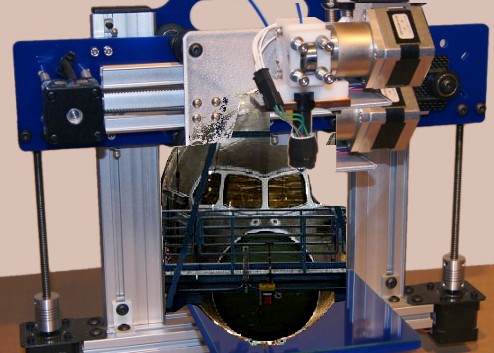
Commercial Airplanes announced their new business model of providing three-dimensional models for printing out airplane parts using 3D printer technology.
“The money is all in the composites-based ‘ink’ refills,” commercial airplanes marketing director Adam Murray explains. “We license the models, lease the large 3D printer tools and sell thousands of ink cartridges just to print out your basic 787 fuselage aft section.”
“Click, Print, Fly,” is the new tagline for the sales campaign. 3D printer technology is becoming more affordable and pervasive across the industry. The latest machines are supporting an increasing variety of materials, including the composites that Boeing uses to manufacture its 787 mid-size airliner.
WebEx Beach Ball lets You Literally Pass the Ball

A new WebEx promotion spices up face-to-face meetings
with a limited edition beach ball. The beach ball allows meeting
attendees to literally “pass the ball” when they have
something to say. “The ball brings engaging exercise into meetings,
with increased participation from the improved blood flow,”
explained a Beach Ball Transition Team Captain, Cindy Watchman.
“Plus, it provides a consistent feel with the online meeting
tools.” The balls are stationed in conference rooms near the
Polycon phones as part of a new Workplace Well Being initiative in
conjunction with Cisco, the makers of WebEx. The WebEx ball also gives
something for participants to do during the obligatory 10-minute laptop
boot-up and meeting setup process.
![]() Comment on How WBB Will Enhance Your Face-to-Faces
Order a WBB for Your Conference Room
Comment on How WBB Will Enhance Your Face-to-Faces
Order a WBB for Your Conference Room
BR&T Pilot Program for Lean+ Printers

Space-saving deployment
of the Canon 3560 VirtPrint in
building 33-07.
In a nod to the overall industry trend towards cloud computing and
network virtualization, the PS&ITR division of BR&T has been
selected to participate in a technology pilot for Lean+ printing. Says
Boeing spokesperson Michael Pulaski, "We took a look at the overall
use of paper products, and decided that the best way to cut down on
consumption and energy use was to try virtualization technologies.
The new VirtPrint product line from Canon integrates well to
Boeing's lean cost structure, and new Windows-compatible print
software (available on SoftwareExpress) allows print jobs to be rendered
in a crisp digital image on the employee's desktop. The
printers also reduce wasted time in dealing with paper jams, refilling
trays, or even just walking to the printer." Pulaski went on to
say that if the trial goes well, Boeing may invest in additional
virtualization technologies including Virtual Paycheck, being tried this
week by dozens of avionics employees from the 18-43 building in Kent,
WA.
![]() Browse VirtPrint Success Stories
Site Services VirtPrint Request Form
Browse VirtPrint Success Stories
Site Services VirtPrint Request Form
Stacking Cubicles Improve Office Space Efficiency by 75%

When faced with space
constraints for moving research teams out of Bellevue and into
Seattle’s Development Center, facilities has devised a
revolutionary new system to stack cubicles vertically in order to improve
spacial usage by 75% or more. “We call ‘em bunk cubes,”
said Skip Maylee, “we had all this vertical space to use
up, so I says let's just stick another cube up there.” Tenants of the top cubicle are required to meet (and maintain)
certain body weight criteria and will be issued a special access ladder for
reaching their top cubes. Level 5 and higher employees may have a special
micro staircase installed so they do not have to climb ladders.
Link to Excel file outlining space savings calculations
PAD Excel Macros Auto-Notify Engineers of Failure
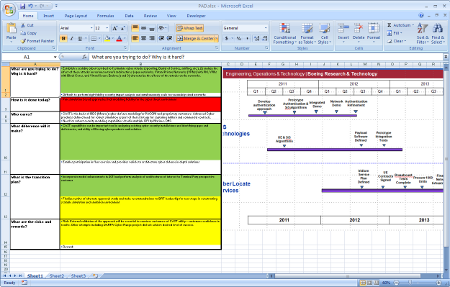
BR&T Engineers that submit Project Authorization
Documents (PADs) to obtain research funding will now be welcomed with an
improved, streamlined process that allows them to enter data directly
into an Excel workbook that features special filtering macros. The macros
detect certain keywords and compare business unit names against a
database of trends and buzzwords, and can immediately assign color codes
based on built-in pass/fail criteria. The macro is also advanced enough
to detect whether the PAD represents a previous project that has simply
been renamed, and whether potential customers have profitable business
needs or are in decline. The development of this advanced system is
expected to save hours of time for both preparation and review,
eliminating the 14-step practice that included trial runs, dry runs,
review processes, down-selection, and consolidation.
Download the new PAD Template
BMRs Recalled due to Faulty Batteries
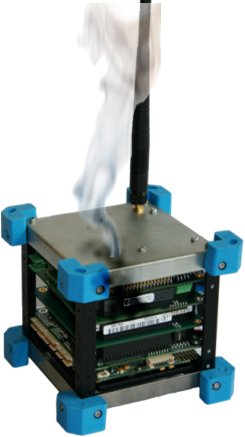
Faulty Lithium-ion batteries are to blame for a recent grounding of all Boeing Mobile Routers (BMRs). “We saw smoke coming from our MANET,” one user recalls, “and then the network just went down, ping didn’t even work.” During the grounding, the devices may still be used for wired routing when connected to AC power, as engineering works around the clock on a solution to the batteries overheating and in some cases even causing fires. The integrated battery compartment is a BMR feature that enables deployment on UAV aircraft and other platforms without requiring any drain on the vehicles’ power systems. Supplier management has identified faulty cells in the manufacturing process affecting some of the units from the Japanese supplier Mutuasi. BMR Serial Number Check Page
Org Chart Becomes News Feed

New RSS feed subscriptions are available, as the standard “Org Chart” or “Organization” page of most Boeing internal organizational websites is now merging with the “News” section. As part of a Lean+ initiative to reduce website clutter, Jimmy Arcana of Lean+ said, “PowerPoint diagrams are so static, we need a more versatile way to reflect the ever-changing business landscape. Sometimes the org charts change so fast, we needed a way to keep up.” View Sample Feeds
Employees Walking Around Without Badges Heightens Security Concerns
 The highly-touted secure badge
program is creating a security nightmare of its own as employees are
increasingly found leaving their badge in the badge reader to login or
unlock their workstation. Site security officials, along with safety
focals, have registered formal complaints with Information Security as
reports increase of employees unable to show proper identification,
employees locked outside of buildings and offices, and people generally
unable to remember other people’s names or identify legitimate
company employees. The different organizations are at odds with each
other, now that passwords have been eliminated and all systems have moved
to the secure badge. Many employees caught without badges cite the slow
badge reader authentication process as a major reason for leaving their
badge in and forgetting about it.
The highly-touted secure badge
program is creating a security nightmare of its own as employees are
increasingly found leaving their badge in the badge reader to login or
unlock their workstation. Site security officials, along with safety
focals, have registered formal complaints with Information Security as
reports increase of employees unable to show proper identification,
employees locked outside of buildings and offices, and people generally
unable to remember other people’s names or identify legitimate
company employees. The different organizations are at odds with each
other, now that passwords have been eliminated and all systems have moved
to the secure badge. Many employees caught without badges cite the slow
badge reader authentication process as a major reason for leaving their
badge in and forgetting about it.
![]() Comment on Solutions to the Safety Crisis
Comment on Solutions to the Safety Crisis
Free Coffee Eliminated, Productivity Plummets
A new study shows
that the recent cost-saving measure that eliminated free coffee and tea
for BR&T employees has actually now cost the company more in lost
productivity. The study showed that the coffee-free environment has led
to fewer invention disclosures, lines of software code, papers submitted
to conferences, and on-time deliverables. “We still have free
water,” said one groggy employee who declined to be identified,
“but the nearest coffee shop to this site would be ten minutes
away.”
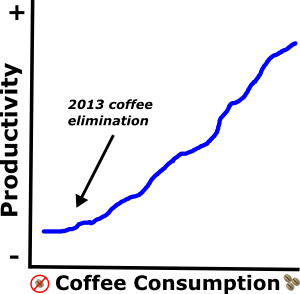
Mandatory Training Developed for Cloud-based Nano Bio Cyber Weapons
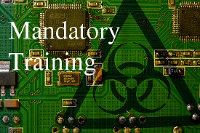
The threat is real, cloud-based, and extremely tiny. A new nano bio cyber weapon awareness training has been developed for employees to be aware of and take precautions for this nano weapon that can infiltrate the company through compromised websites and unfiltered email attachments. “Employees aren’t aware of the dangers of this new type of threat, and we’re working to change that,” remarks Boeing IT Security Subject Matter Expert Rob Grannin. Once internal computing systems have been infected, they can cause nanodust particles to be generated in everyday printer jobs. The nanodust may then be inhaled by unsuspecting targets, and have biological effects that can lead to cyber exfiltration and even a “spear phising” like targeting of individuals, according to Grannin.